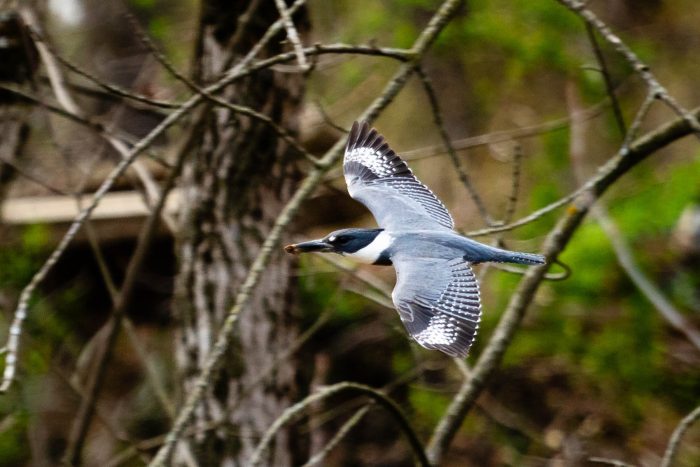Belted kingfisher
Megaceryle alcyon
The belted kingfisher is a stocky, powder blue bird that can be found in the Chesapeake region year-round.
This section shows one large critter image at a time. Use the thumbnails that follow to select a specific image to display here.

This gallery contains a grid of small thumbnails. Selecting a thumbnail will change the main image in the preceding section.
Appearance
The belted kingfisher is a stocky bird with a large head. It grows to be between 11 and 14 inches in length with a wingspan of 19 to 33 inches. It has a shaggy crest on the top and back of its head; a short, thick bill; and short legs. Its medium tail is square-tipped.
The belted kingfisher is powder blue on top with fine, white spotting on its wings and tail. Its white underparts also feature a blue breast band. Females have a broad, rusty band on their bellies while juveniles have irregular rusty spotting on their breast band.
Feeding
Belted kingfishers mainly eat small fish, including sticklebacks, mummichogs, trout and stonerollers. They will also eat crayfish, mollusks, insects, small amphibians and berries. They hunt by plunging directly from a perch or hovering over the water, bill downward, and diving after a fish.
Predators
Hawks, mammals and snakes eat belted kingfishers. When chased by hawks, belted kingfishers will dive into the water repeatedly until the predator flies away.
Voice
The belted kingfisher makes a wild, rattling call.
Reproduction and life cycle
Belted kingfishers spend most of their time alone, until they pair up for breeding season. They build nests near or sometimes along a waterways for easy access to fish. They’ll burrow into the ground, generally extending a few feet and sloping upward so water doesn’t collect inside.
Belted kingfishers breed once a year, between April and July depending on the location. Females lay five to eight oval, glossy white eggs in the burrows, which hatch within a month. After six weeks, juveniles are independent.
Did you know?
- The belted kingfisher is one of a few bird species in which the female is more brightly colored than the male.
- Human activity, including building roads and digging gravel pits, has actually helped expand the kingfisher’s breeding range by creating banks where they can nest.
Sources and additional information
- Animal Diversity Web: Megaceryle alcyon – University of Michigan Museum of Zoology
- All About Birds: Belted Kingfisher – The Cornell Lab of Ornithology
- Guide to North American Birds: Belted Kingfisher – Audubon
